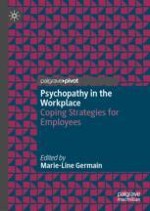2024 | OriginalPaper | Chapter
3. Assessing Psychopathy in the Workplace
Authors : Russ Curtis, John Sherlock, Russell Frelinghuysen
Published in: Psychopathy in the Workplace
Publisher: Springer International Publishing
Activate our intelligent search to find suitable subject content or patents.
Select sections of text to find matching patents with Artificial Intelligence. powered by
Select sections of text to find additional relevant content using AI-assisted search. powered by
